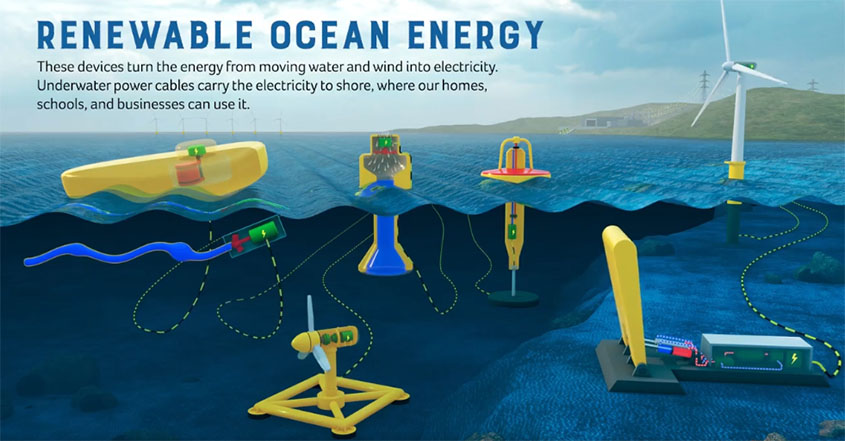Ocean Energy? River Power? There Is a Toolkit for That
Revamped Software Offers Marine Energy Industry the Data It Needs To Succeed

Is marine energy finally here?
This question, in various forms, pops up in news articles every year if not every month. In 2021, Wired Magazine claimed, “The United States is finally trying to unlock the power of wave energy.” In 2022, the The Wall Street Journal asked, “Can the ocean help save the planet?”
The simple answer is yes, the ocean—specifically clean energy generated from waves, tides, and ocean and river currents—can help save the planet. The energy available from this renewable energy resource, called marine energy, is equivalent to about 80% of the United States’ annual electricity needs. Although some of that power cannot be practically harnessed, to build a 100% clean energy future, the world needs all the renewable energy it can get.
Now, marine energy developers can start building this future faster (and cheaper) with the Marine and Hydrokinetic Toolkit (MHKiT), a massive, searchable, open-source knowledge hub that provides developers with the code needed to analyze how well their technology might perform in various ocean and river sites. Recently updated, the toolkit now includes data on tidal and river energy resources, factors (like turbulence and sediment) that affect how technology functions underwater, analysis of extreme waves, and more.
“I’m really eager to help solve climate change in any way I can,” said Rebecca Fao, a researcher at the National Renewable Energy Laboratory (NREL) who helped develop MHKiT. “Clean energy, including marine energy, has a key role to play in that, so I'm keen to see it take off. It may seem like a small piece of the puzzle, but without good quality data, the industry cannot move forward.”
Ocean energy can help save the planet. But how this budding industry achieves commercial use is a far more complicated question. To provide a data road map, NREL researchers partnered with the Pacific Northwest National Laboratory and Sandia National Laboratories to develop the first version of MHKiT, which ingests, processes, visualizes, and manages data on everything from a device’s power production and ability to withstand various mechanical loads to how much energy flows through ocean and river sites across the United States.
Before MHKiT, developers had to design their own code to analyze how well their technology performed during a wave tank or open ocean test. But code development—and validation—can be time consuming and expensive. MHKiT’s shared software and data are not only free but standardized and quality controlled, too.
“Standardization is really key,” Fao said, “so everybody is drawing the same conclusions about the performance of their devices or designs.” Developers need to both collect and process high-quality data to prepare their technology to survive a specific river site and learn what goes right (and wrong) out at sea.
MHKiT can help with all of that. Created in 2019 with funding from the U.S. Department of Energy’s Water Power Technologies Office, the software is available in both Python and MATLAB. Now, the MHKiT team is releasing more robust versions for each platform.
On its Python platform, MHKiT now houses data for tidal and river resources, including how much energy is available at which sites, how fast and turbulent the waters are at those sites, and what underwater obstacles—like sand and stones—might interfere with a device’s performance. (For the marine energy diehards, this means data from Acoustic Doppler Current Profilers and Delft3D.)
Plus, wave energy developers can now analyze extreme waves their machines might face at their chosen deployment site. Unprepared devices might not survive those waves; with MHKiT, developers can increase the likelihood they will endure.
On the MATLAB platform, the MHKiT team pulls in lots of data—like wave heights, current speeds, and water temperatures—gathered by a troupe of buoys managed by the Coastal Data Information Program. To better predict the weather and climates that marine energy technology might face offshore, the MHKiT team added historical wave data, too. When complete, this so-called hindcast dataset will cover the entire United States.
Just four years old, MHKiT is already a popular tool, downloaded over 4,000 times (although some of those downloads are repeat customers coming back for more).
Next, the toolkit’s development team plans to integrate even more data and functionality to account for hybrid energy systems—like those that pair floating wind turbines or solar panels with marine energy devices—and for smaller, niche technologies used to power the blue economy. These include unmanned sea drones for ocean exploration or wave-powered desalination devices to produce clean drinking water in remote locations or to support disaster relief efforts.
The more robust MHKiT gets, the faster the marine energy industry can reach commercialization and change those speculative headlines into definitive statements, like “Marine Energy Is Finally Here.”
Want more in-depth information on the latest version of MHKiT? Join NREL and the rest of the software development team for a Marine and Hydrokinetic Toolkit (MHKiT) Updates and Demonstration webinar at 1 p.m. ET on March 31, 2022.
Learn more about NREL's marine energy research and tools. And remember to subscribe to NREL’s water power newsletter to make sure you do not miss an update.

